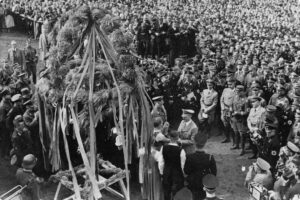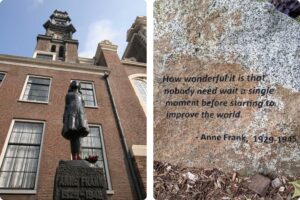Anne Frank was born on 12 June 1929 in Frankfurt am Main, Germany. A teenager with dreams of a bright future, Anne made history through her diary, which continues to inspire millions around the world. Her life, like that of countless other Jews, was tragically disrupted by the rise of Nazism.
In 1933, Adolf Hitler came to power. Anne’s family fled to Amsterdam, hoping to escape the increasing persecution in Germany. They settled into a relatively normal life in the Netherlands. However, the German occupation of the Netherlands in 1940 brought escalating challenges for Jewish families. Daily life became fraught with discrimination, restricted freedoms, and the constant threat of deportation.
Life in the secret annex
On 6 July 1942, the Frank family went into hiding in the Secret Annex, a concealed space behind Otto Frank’s office. Alongside four others, they spent over two years in silence and fear, desperately hoping to survive the war.
During this period, Anne wrote extensively in her diary, which she named ‘Kitty’. This diary became her closest companion and a place to record her thoughts, fears, and aspirations. In her writings, Anne detailed the challenges of living in hiding, the scarcity of food, and the constant need for silence. But she also shared her innermost feelings, including her dreams of becoming a writer or journalist and her hope to make a positive difference in the world.
One of Anne Frank’s most famous statements, ‘despite everything, I still believe in the goodness of man‘,highlights her remarkable optimism and faith in humanity, even during the darkest times.
A tragic end
In August 1944, the people in hiding were betrayed and arrested. Anne and her sister Margot were deported to Auschwitz and later to Bergen-Belsen, where they tragically succumbed to typhoid in March 1945, just weeks before the camp was liberated. Otto Frank, Anne’s father, was the only survivor of the family.
After the war, Otto discovered Anne’s diary and made it his mission to share her story with the world. In 1947, the diary was first published under the title ‘The diary of Anne Frank‘. Since then, it has been translated into over 70 languages and read by millions worldwide, cementing Anne’s legacy as a voice of resilience and hope.
Anne Frank’s Legacy
Today, the Anne Frank House in Amsterdam stands as a powerful reminder of her story. This museum, located in the building where the Secret Annex was hidden, attracts visitors from all over the globe. It offers a poignant glimpse into Anne’s life and the enduring relevance of her message.
Anne Frank’s story is not only a reflection of the atrocities of war but also a testament to the resilience of the human spirit. Her unwavering belief in a better world and her profound faith in humanity continue to inspire generations.
Want to learn more about Anne Frank and Amsterdam? Explore the city with the SmartWalk Amsterdam self-guided tour and visit the Secret Annex at your own pace. Discover the history, culture, and hope that Anne Frank’s legacy embodies.







